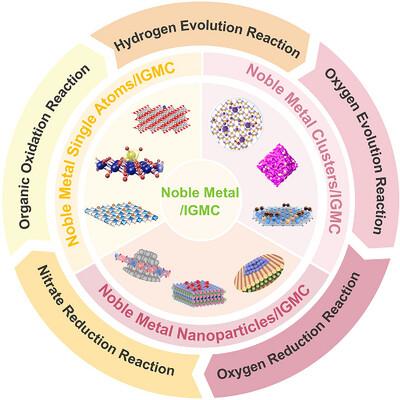Noble Metal/Iron-Group Metal Compound Composite Catalysts: Characterization, Synthesis, and Electrocatalytic Application
IF 12.1
2区 材料科学
Q1 CHEMISTRY, MULTIDISCIPLINARY
引用次数: 0
Abstract
Electrocatalysis is hindered by challenges such as the scarcity and high cost of noble metals, as well as the deactivation of active sites under reaction conditions. While iron-group metal compound (IGMC) offer abundant reserves and unique electronic structures, it often suffers- from high overpotentials and insufficient stability, limiting its practical applications. Noble metal/IGMC composite catalysts address these issues by enabling precise tuning of electronic structures through hybrid synthesis strategies, thereby enhancing catalytic activity and establishing efficient synergistic mechanisms. This review categorizes noble metal/IGMC composite systems based on noble metal size (single atoms, clusters, nanoparticles), comprehensively summarizing research progress in this field. It focuses on elaborating synthesis strategies for different size-based systems, while delving into the synergistic enhancement mechanisms at multi-component interfaces during electrocatalysis, and analyzing the regulatory role of strong metal-support interaction (SMSI). By integrating multi-scale characterization techniques and electrocatalytic application studies, the dynamic reconstruction rules of active sites and their practical application potentials are deeply revealed, providing critical theoretical support and scientific guidance for the rational design of high-performance catalytic materials.

贵金属/铁基金属复合催化剂:表征、合成及电催化应用
电催化受到贵金属的稀缺和高成本以及反应条件下活性位点失活等挑战的阻碍。铁族金属化合物(IGMC)储量丰富,电子结构独特,但其过电位高,稳定性差,限制了其实际应用。贵金属/IGMC复合催化剂通过混合合成策略实现电子结构的精确调谐,从而提高催化活性并建立有效的协同机制,从而解决了这些问题。本文根据贵金属的大小(单原子、团簇、纳米颗粒)对贵金属/IGMC复合体系进行了分类,全面总结了该领域的研究进展。重点阐述了不同尺寸体系的合成策略,同时深入研究了电催化过程中多组分界面的协同增强机制,并分析了强金属-支撑相互作用(SMSI)的调节作用。通过多尺度表征技术与电催化应用研究的结合,深入揭示活性位点的动态重构规律及其实际应用潜力,为高性能催化材料的合理设计提供关键的理论支持和科学指导。
本文章由计算机程序翻译,如有差异,请以英文原文为准。
求助全文
约1分钟内获得全文
求助全文
来源期刊

Small
工程技术-材料科学:综合
CiteScore
17.70
自引率
3.80%
发文量
1830
审稿时长
2.1 months
期刊介绍:
Small serves as an exceptional platform for both experimental and theoretical studies in fundamental and applied interdisciplinary research at the nano- and microscale. The journal offers a compelling mix of peer-reviewed Research Articles, Reviews, Perspectives, and Comments.
With a remarkable 2022 Journal Impact Factor of 13.3 (Journal Citation Reports from Clarivate Analytics, 2023), Small remains among the top multidisciplinary journals, covering a wide range of topics at the interface of materials science, chemistry, physics, engineering, medicine, and biology.
Small's readership includes biochemists, biologists, biomedical scientists, chemists, engineers, information technologists, materials scientists, physicists, and theoreticians alike.
 求助内容:
求助内容: 应助结果提醒方式:
应助结果提醒方式:


